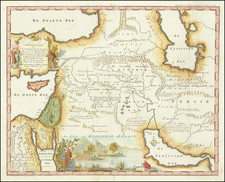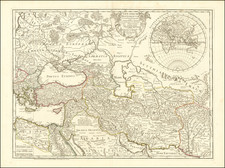"Vorder Asien" is an impressively detailed map of Western Asia, drafted by A. and C. Graf and produced by the Geographical Institute in Weimar in 1866. The map encompasses regions including Anatolia, Syria, Arabia, Iran, Turan, Baluchistan, Afghanistan, the lands along the Euphrates and Tigris, and the countries of the Caucasus, all represented at a scale of 1:8,000,000.
This map delineates political boundaries in Western Asia during the mid-19th century, clearly marking out the Ottoman Empire, the Russian Empire, the Sultanate of the Wahhabis (modern-day Saudi Arabia), the Realm of the Imam of Oman (Muscat), British possessions, and Portuguese possessions. The representation of these various political entities provides an essential glimpse into the geopolitical realities of Western Asia during this period.
The terrain is rendered with exceptional accuracy and detail by L. Kraatz, revealing the region's topographical characteristics and facilitating an understanding of how geography shaped historical events and human activities. The varying textures and contours lend depth to the region's diverse landscapes, from the rugged mountain ranges to the fertile river valleys.
The map's legend, "Erklärung," presents a comprehensive guide to interpreting geographic nomenclatures in the map's featured Asian languages, including Arabic, Persian, and Turkish. This feature, unique to the time period, reflects a deep understanding of the region's linguistic diversity and offers a significant educational element to the map. The legend also assists in translating the topographic symbols and abbreviations, enhancing the user's comprehension and engagement with the map.










![(Second World War - Oilfields) Vorderasien mit seinen Erdölgebieten [Western Asia with Its Oil Fields]](https://storage.googleapis.com/raremaps/img/small/87373.jpg)
![An Account of the Kingdom of Caubul, and its Dependencies in Persia, Tartary, and India; Comprising a View of the Afghaun Nation, and a History of the Dooraunee Monarchy [with map:] A Map of the Kingdom of Caubul, and some of the Neighbouring Countries](https://storage.googleapis.com/raremaps/img/small/89552.jpg)
![[ Ancient Persia and Environs ] Regiones Mare Hyrcanum Oxum Fl, et Indicum Pels sitae](https://storage.googleapis.com/raremaps/img/small/102032.jpg)

![[Armenia] Armenia Vetus In Quattuor Partes distincta ad Tepora Iustiniana Imp. . . . 1653](https://storage.googleapis.com/raremaps/img/small/91739.jpg)